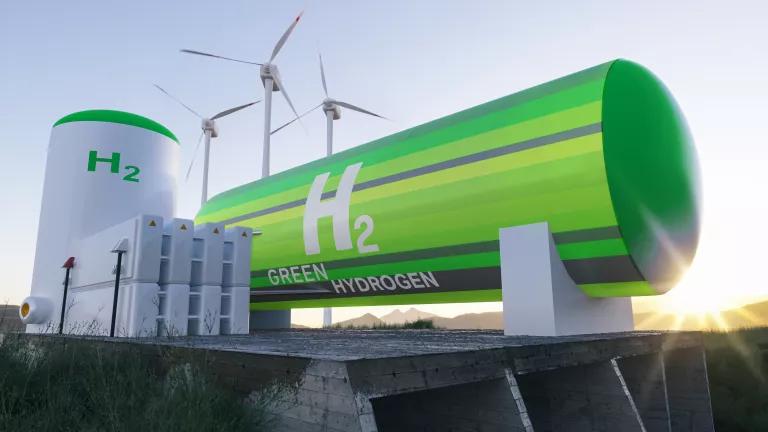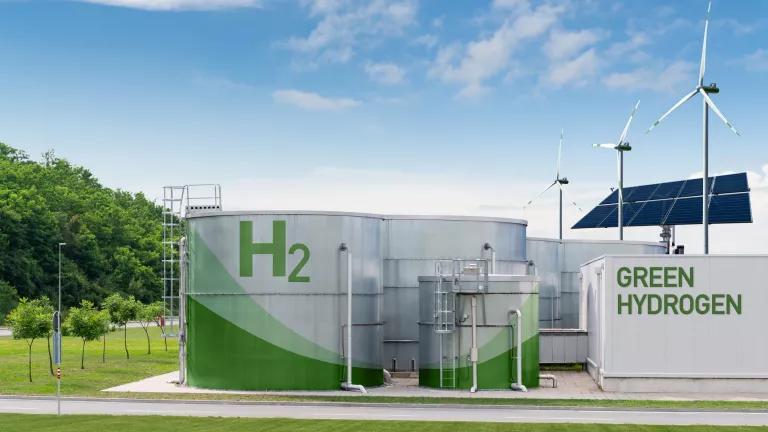Colorado Leads the Way with a Climate-aligned Hydrogen Course
The Biden administration and other states should take note and follow suit.

Since the Department of Energy announced its $8 billion hydrogen hubs program, states across the country have been leaping at the opportunity to take a leading role in developing a hydrogen market. In an effort to sharpen their part of the Western Interstate Hydrogen Hub (WISHH) bid and enhance their prospects of being selected as a DOE hydrogen hub, Colorado’s legislature passed a bill at the tail end of the recent session to layer state hydrogen incentives on top of the lucrative federal incentives under the Inflation Reduction Act. In passing HB23-1281, they also took an enormous step to ensure clean hydrogen really does lower emissions and strengthens the clean energy transition.
The bill ensures guardrails will be in place to protect against increases in climate-harming pollution from hydrogen production, and targets the usage of hydrogen at hard-to-decarbonize sectors where electrification may not be feasible. Colorado is setting an example that other states, and the Treasury, who are busily working out the details of the IRA hydrogen tax credits, would be wise to pay attention to.
Hydrogen has the potential to decarbonize several hard-to-electrify sectors, such as steelmaking and long distance shipping, and is therefore critical in achieving a clean economy and U.S. climate goals.. Recognizing this, the federal government is putting up billions of dollars in subsidies to get a clean hydrogen market off the ground in the next decade.
States are now joining the game, and Colorado just passed the best, most climate-aligned state hydrogen subsidy yet. Blessed with excellent wind and solar resources, with the subsidies on offer from the federal government and now the state, Colorado is well-positioned to jump-start a truly clean hydrogen sector and avoid the worst of the potential environmental impacts of an unregulated hydrogen market.
A nation-leading standard: The bill defines “clean hydrogen” based on the three pillars of additionality, hourly matching and deliverability
The bill directs the Public Utilities Commission (PUC) to define clean hydrogen for the purposes of a targeted end-use tax credit and the approval of investor owned utility hydrogen projects. These rules are based on the “3 pillars” of new clean supply (or additionality), deliverability and hourly matching—critical guardrails that are necessary to prevent emissions increases on the electricity grid as a result of power-hungry electrolyzers. You can read more about the necessity of the three pillars and the weaknesses of the arguments against them in our previous blogs and listen to this Volts podcast.
The deadline for the PUC to implement the 3 pillars is either as soon as the Treasury implements for the IRA 45V hydrogen production tax credit when 200 megawatts (MW) of electrolyzers are operational in the state, or by January 1st 2028, whichever comes soonest. Given that this will be a public rulemaking by PUC, there will be opportunities for stakeholders to push for the soonest possible implementation of these critical guardrails, but the 200 MW deployment backstop in the bill and the lack of grandfathering of first mover projects under initial looser rules offers a good buffer against any ill effects of a phase-in of the pillars.
The two pillars of new clean supply (or additionality) and deliverability were both accepted as necessary by many Colorado stakeholders. However, the hourly-matching pillar, requiring that power consumption by electrolyzers be matched with power generation from new renewables on an hourly basis, was particularly controversial. Some large industry groups fought hard for an amendment delaying and potentially removing the hourly-matching requirement on economic grounds – despite an ever-growing collection of peer-reviewed studies and reports showing that hourly-matched hydrogen projects can be very cost-competitive from day 1, especially in such a renewables-rich state as Colorado. Thankfully, legislators stood strong and prioritized the climate and hard facts over corporate profits, resulting in the hourly matching provision in the bill we have today.
The bill would channel clean hydrogen into hard-to-electrify sectors and protect communities from harm
Another notable success in this bill is the targeted nature of the end-use tax credit – only hard-to-electrify uses, including industrial heat over 150 C, steelmaking and use as a chemical feedstock, are eligible for the state subsidy. As we have extensively written in previous blogs and testimony, hydrogen should be reserved for challenging applications where electrification may not be feasible, as direct electrification is far more cost-effective and efficient wherever it is viable. The targeted approach adopted in the Colorado bill rightfully recognizes those dynamics and will drive a clean hydrogen market that has long-term sustainable users and is much more likely to survive any credit-cliff when government subsidies expire.
In addition, the bill offers protections for disproportionately affected communities who have for too long suffered from industrial pollution. Investor-owned utilities seeking approval for clean hydrogen projects will be required to undertake cumulative impacts studies to investigate potential impacts to air quality, water quality and availability, and other public health concerns from hydrogen production. Air quality is a particular concern because of the potential for high NOx emissions from combusting hydrogen, and Colorado’s severe non-attainment of federal ozone standards. The legislation requires the Public Utilities Commission to reject any proposal that would increase negative cumulative impacts in a community.
The bill opens an unnecessarily wide door for hydrogen blending in power plants, resulting in climate risks
The bill permits the use of hydrogen blended with natural gas in power plants, with no specific guardrails around when these power plants must close or move to 100% hydrogen. This is troubling, especially given that the state lacks a binding target for power sector decarbonization that would guard against the risk that those gas plants continue to emit pollution with impunity; the Governor’s stated goal of 100% renewable energy by 2040, an admirable goal, is not yet codified in law. Binding rules to both guarantee no gas plants will extend beyond their planned retirement as a result of hydrogen blending, and that only 100% hydrogen without blending will be combusted beyond 2040, are needed.
Colorado is now an exemplar of hydrogen policy, with nation-leading clean hydrogen standards and a targeted end-use focus.
On balance, HB23-1281 has set a high bar for other states to follow and puts Colorado right at the forefront of the nascent clean hydrogen market. Pennsylvania, who passed an unfortunately weak hydrogen bill in the fall of 2022, including a natural gas subsidy and minimal guardrails around hydrogen production, could look to this bill for inspiration in remedying that. Other states who wish to attract DOE hydrogen hub funding should also look closely to what Colorado is doing to guide a climate- and community-aligned hydrogen market in their state. After all, DOE have made clear their intention to prioritize hubs that maximize emissions reductions, and according to multiple studies, that means requiring hydrogen production to meet the three pillars and targeting hydrogen usage at hard-to-electrify sectors.
Hopefully, Treasury, the Department of Energy and the White House are also paying close attention. With all eyes on them for the upcoming regulations on the IRA 45V clean hydrogen production tax credit, they should follow the precedent set by Colorado and embrace the three pillars. That decision is even more consequential, given the billions of dollars of U.S. taxpayers dollars at stake, and market-defining nature of the 45V credit.
HB23-1281 is the first major example of clean hydrogen policy in the U.S. Colorado rose to the task and charted an exemplar course. The Biden administration and other states should follow suit.




